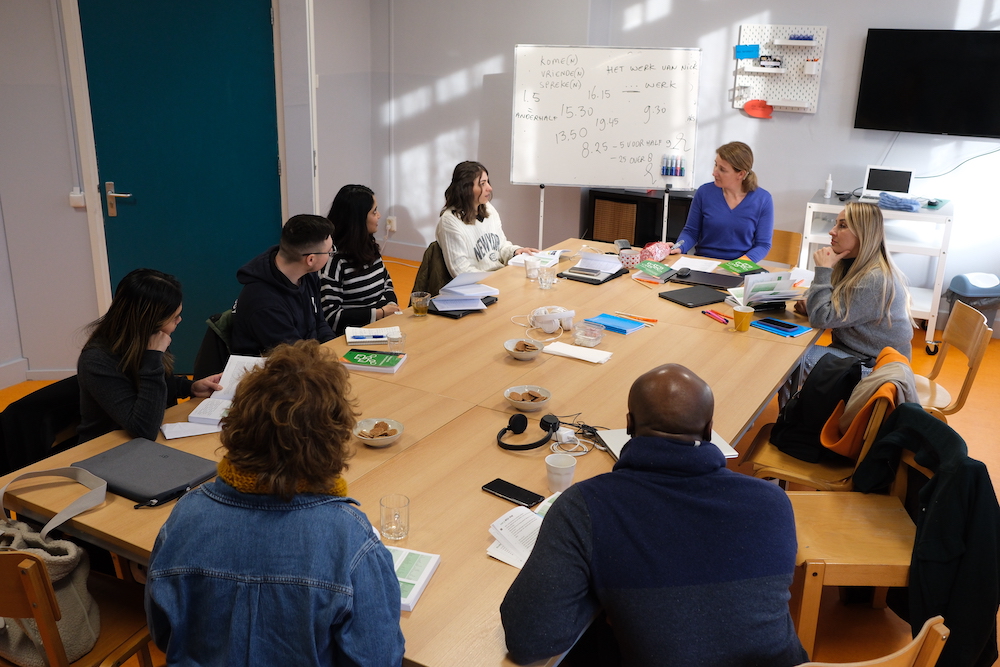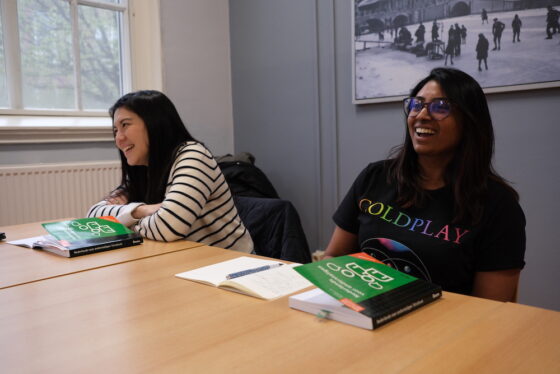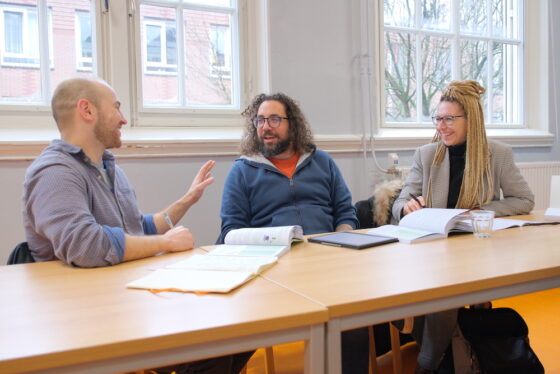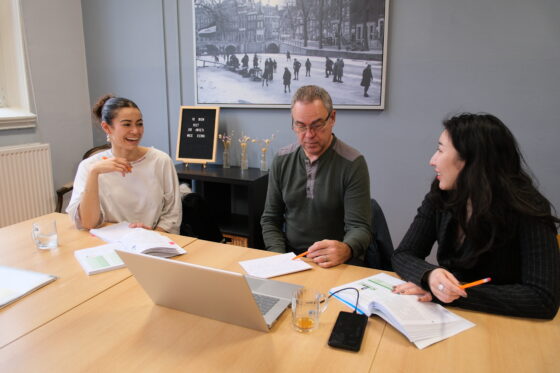Partner content
Make real progress: Tips and tricks to get talking Dutch

“I should have done it 10 years ago,” says Bill Bosler, a 61-year-old American sitting in a room of students wrestling with basic Dutch.
This small group is taking an intensive language course at the NedLes language institute in Amsterdam. Before each lesson, they study a text repeatedly using an interactive, online environment – then the lesson is all about actually speaking.
“I thought I needed an in-person, head-down push,” says Bill. “The forced repetitiveness isn’t something I did in other courses. You aren’t made to say anything, or say it right.”
But this “Delft method” course is different, says Tim Mamo, 43, and from Malta. Although he has lived in the Netherlands for seven years, only now he is really making progress with the language. “Force yourself to speak,” he advises other learners. “Mangle it, butcher it, then get corrected.”
And give yourself the time to do it, adds fellow student Michaela Kohutová, 39, from the Czech Republic. “The sentence structure and also the words don’t feel natural,” she says. “But we are very patient with each other and everyone has a space to create sentences.”
This early lesson with the patient and smiley teacher Nathalie Weisz goes slowly, and a few students are clearly confounded when a past tense sentence turns out to need the verb “to be”, zijn, not “to have”, hebben. “Ze is geweest,” they repeat, doubtfully.
This entire method, with its intense but logical process, aims to stop people panicking and get them learning in the most natural way. The best tip, says director and teacher Renske Berns, is just to dive in without even asking: “but, why?”
Speak easy
“When you start with the Delft method, there is even a chance that a mental block doesn’t appear because you don’t reach that moment of panic,” says fellow teacher-director Welmoed Nijhout. “You’re just copying a sentence and your teacher makes maybe some hand signals to correct you until you’re doing it right.

“Whereas if someone starts writing on a massive board: this is Dutch word order, it’s very difficult and it’s completely different from other languages, there’s a mental block. Whereas if you just said: ‘can I get you a coffee?’ and the words were in a different order but you copied it because you had heard it 20 times, there’s no block.”
Learning a language like a child who listens and repeats is key to getting over what might initially feel like the most alien aspect of Dutch: its sentence structure. Instead, by building up a kind of “mental muscle memory”, your Dutch database will steadily grow.
“It’s often when we become really aware of grammar that we become so stressed,” says Renske.“Children can’t explain to you where the verb in Dutch goes, of course, but they know how it works because they’ve heard it so many times. They develop the subconscious knowledge of grammar that you have in your mother tongue. While the fact that you can explicitly name all the rules doesn’t help you speak. It’s almost like they are two completely different rooms in your head.”
Tips and tricks
If you have invested in an intensive, Delft method course – which NedLes believes is one of the best ways to make yourself lean in and learn – you must really commit, say Welmoed and Renske. Some of its courses are twice weekly, but the truly intensive two-week programme has two lessons a day, five days a week. (Almost as immersive as a residential course, remarks Bill, but less expensive!)
In between intensive periods of formal learning, there are all kinds of ways to ratchet up your Dutch, even if you’ve lived in the Netherlands for years without it.
Find things that interest you, most of all. “We don’t advise people to read specifically kids’ things because if they don’t interest you, then you’re not motivated,” says Renske. “If you like sports, read the sports news, if you like interior design, find home magazines or follow accounts on Instagram. If you like true crime or history, find podcasts.”

What’s really important is to keep up what you learned from a course. “If you don’t go to the gym, your muscles go,” says Welmoed. “It’s the same with language learning. Keep in touch with the language.”
Find a sport
Contact with Dutch people is, of course, key. “Dutch people are not always as accessible for friendships,” admits Welmoed. “They often have their family life, a set group of friends they’ve had for very, very long and their team sport. So if you like team sports, join a team sport!”
When you’re building Dutch friendships, don’t be offended if some people flip constantly to English. “It’s not because they think your Dutch is bad: they just think it’s easier to communicate,” says Renske. “They are just efficient and maybe not that patient.”
Be stubborn and keep going, preferably asking for their help. “If you want to practise, you have to be very explicit about it, and don’t feel shy.”
Switch on!
Students at NedLes recommend news programmes on Dutch TV, which have the advantage of being short. There’s a daily “easy” NOS news at 5pm and on YouTube, created for some two million Dutch people who struggle with the language (too).
Others find the youth TV news programme, NOS Jeugdjournaal helpful because the language is simpler and complex words are explained. Be warned that the topics, though, are child-focused. “You will hear about a lot of elephants being born,” says Renske. “If you’re not into those topics, then maybe it’s better to watch the normal news in simple language.”
Put on the subtitles and don’t be afraid to pause or re-watch the same item 10 times over to understand every word. “Engage,” agrees Welmoed. “If you hear a word, try to figure out what it is. Make it a game.”
You might also have a reading device that allows you to save words you have translated, so that you can embed them in your mind by repeating them.
Tech savvy
The only way to learn to speak Dutch is to do it, without worrying that people are going to treat you like an infant. “It’s not kind if people are not patient,” says Renske. And if locals want foreigners to speak their language, they need to slow down and be helpful, rather than just switch to English!

Technology can help too. Keeley Schulman, 23 and from Washington in the USA, is working towards an exam for a partner visa in the Netherlands after falling for a Dutchman. “I use ChatGPT a lot,” she says. “It’s really helped me stay up to pace. When I’m doing the homework, I’ll ask: why is it this and not this? The same questions you would ask a teacher.”
Especially at the start, though, you have to accept the reality of Dutch and this is what the small class does, puzzling a way through sentences. “Ze is…bij haar vrienden…op bezoek geweest,” they read slowly from the white board. She was visiting her friends.
As they joke – in simple Dutch – about how bad your weather has to be to move to the Netherlands for the sun, this is a place of language learners and of friends. “In these difficult times, this is a lovely melting pot of people from the whole world, busy with just one problem,” says Welmoed. “Learning Dutch!”
Do the free test to find your level and sign up for the next course at NedLes
Thank you for donating to DutchNews.nl.
We could not provide the Dutch News service, and keep it free of charge, without the generous support of our readers. Your donations allow us to report on issues you tell us matter, and provide you with a summary of the most important Dutch news each day.
Make a donation